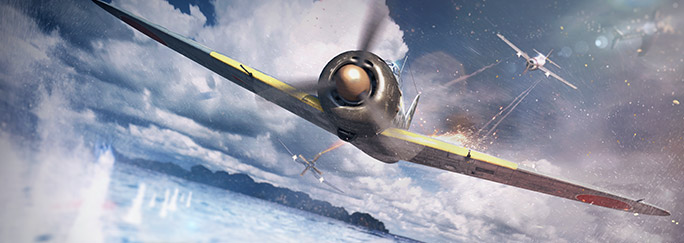-
![LANG-CODE-KEY]() LANG_NAME_KEY
LANG_NAME_KEY

Pilots,
They say that history is written by the victor, which, in the case of the Battle of the Philippine Sea, must mean that it was the Allies who wrote down and thus immortalised the events of this epic battle. Although the outcome of the encounter was never in doubt, the Japanese gave the U.S. navy, men, and pilots a run for their money, as both sides threw in everything they had to defeat their opponent. The result was one of the most memorable military operations between both heavily-entrenched belligerents, who would go on to clash many more times in the fight for domination over the Pacific. Read the true story behind the event in our History Flashback below and enjoy great discounts to commemorate the occasion!
‘Battle of the Philippine Sea’ Special | ||
|---|---|---|
|
All offers and missions will be available |
||
Triple XP for 1st victory with every plane in your hangar
The side with the most experience wins in the majority of cases. So level up today!
50% discount on consumables
Stock up on helpful consumables while we slash their prices like there’s no tomorrow!
50% discount on the following planes:
 |
Brewster F2A Buffalo |
|||
 |
Mitsubishi A6M1 Zero |
|||
 |
Grumman F4F Wildcat |
|||
 |
Mitsubishi A6M2 Zero |
Classic battles require classic opponents. Pick up the best from both sides at half price today!
30% discount on the following planes:
 |
Chance-Vought F4U-1 Corsair |
|||
 |
Mitsubishi A6M5 Zero |
|||
 |
Chance-Vought F4U-4 Corsair |
|||
 |
Mitsubishi A7M Reppu |
Prolong the fight of East vs. West by flying any of these historic warbirds!
Instead of just giving out the usual one reward per mission, this week, we’re increasing the bonuses to two! Don’t miss your chance to score big!
|
Crushing the Waves | |
|---|---|
|
Goal |
Destroy at least 3 enemy aircraft in one battle and win flying the required aircraft. |
|
Reward |
|
|
Conditions |
|
After Pearl Harbor in December 1941, the US was at war with Japan, fighting in the Pacific for control over the Ocean’s islands and the territories of East Asia. Having driven the Japanese out of the island chains around Papua New Guinea by early 1944, the American military leaders focused on the Northern Mariana Islands. They believed that this spot, around 2,400 km south of Tokyo, was a strategically important location that would be close enough for a long distance attack by US B-29 bombers on the Japanese mainland. They dispatched the fifth US fleet, consisting of 15 carriers, 7 battle ships, 79 other ships, 28 submarines and over 900 warplanes (mostly F6F Hellcats). The offensive was due to hit the Mariana Islands capital Saipan on 15 June 1944.
 |
 |
 |
|
Pictures from before (left), during (middle) and after (right) the Battle of the Philippine Sea. |
At the same time, the Japanese navy was gathering its ships and airplanes in the Philippine region, readying for a vicious counter-attack that would put an end to US sea-dominance once and for all. With all of the US war successes being largely amphibious-based, the Japanese believed that stopping the Americans at sea would limit their capabilities to move troops to shore, essentially eliminating the danger they posed. Convinced of their winning strategy, they assembled a huge fleet consisting of 9 carriers, 5 battle ships, 43 smaller vessels, and 681 light carrier-based fighters (mostly A6M Zeros) and met the Americans on 16 June for one final decisive battle of the sea and air.
Both opponents dispatched their air fleets, which met at the islands of Guam and Rota for the big clash. However, the anticipated heavyweight fight proved to be a lopsided rout of epic proportions. Outnumbered and without any real support from their own ships, the Japanese air fleet was decimated by the superior Hellcats and heavy anti-aircraft fire of the US vessels. Around three quarters of their carrier-based A6Ms were taken out in the first wave of this furious attack alone. Most of the remaining hundred or so were outmanoeuvred and blown to pieces by the quicker and more heavily-armoured F6F Hellcats, which sustained only 29 losses of their own. The US pilots nicknamed the encounter as the “Great Mariana Turkey Shoot” due to the one-sided nature of the battle.
The result was that the great sea battle ended before it had really begun, with a very definitive victory for the Americans. The same day, the US seized their advantage and using submarines, they sank two Japanese carriers. The following day, the US proceeded to successfully track down the rest of the Japanese fleet on open water and attacked with over 200 planes, hitting several vessels including the carrier ship “Hiyo”. By the end, the Japanese only had 35 planes left out of the hundreds they had brought with them.
Have your own Great Mariana Turkey Shoot in-game, pilots!